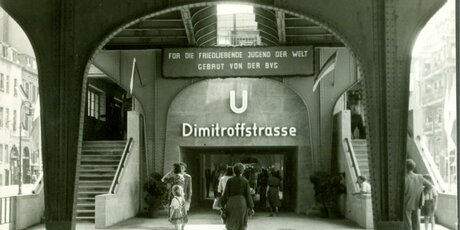The district Pankow at GDR times
The beginning and end of the German Democratic Republictook place in the Berliner old city district of Pankow. The first independentstate ceremony of the young Republic in 1949 and the international “Two-plus-Four Talks” to resolve this State entity nearly a generation later in 1990,took placein the same historical location: Schönhausen Palace in Pankow.
The old city districts in the North of Berlin were traditionallythe industrial and commercial areasalong the major traffic routes.In the old Pankow district, should be mentioned the plant manufacturer Bergmann, later known asBergmann-Borsig, the metal company Niles and theclinicand science complexes in Buch. In Weißensee, one can remember the business premises of Askania and Steremat, but also of Sternradio of later years. In the old Prenzlauer Berg,the gas plant and the central stockyard played an important role in the growth of the large Berlin city organism.
Right after the defeat of the Third Reich in 1945, Pankow was chosen for a settlement of the newly emerging German Communist nomenklatura.The famous “little town” on the Majakowski-Ring was set-up.In the Schönhausen Palace, the correct constitutional version of the smaller German state was founded.Here,President Wilhelm Pieck swore in the first Government. He residednot far from the palace, otherrepresentatives of the SED not far off. For a long time, Pankow was not only a synonym for East of Berlin–the Soviet sector.“Pankow” established itself in the Westas a collective term for the GDR.
Also, inthe Berliner North,thedays around the 17thof June 1953 left the citizens in an unsure state. Riots rocked the Pankow businesses. The Socialist model company Bergmann-Borsig shut down the work completely.
In the 80s a number of oppositionassociations emerged in the three districts of the old town.Peace groups and independent artists were looking for new ways to freely develop their ideas.It was also thanks to them that the Berlin Wall fell on the night between the 9th and 10thofNovember 1989 at the Bösebrücke in Prenzlauer Berg and soended the cold war in Europe.
From December 1989 the central round table of the Republic met in Pankow that helped to prevent the open collapse of the GDR. But it was also in the district that the Pankow Model evolved for the municipalroundtable. The focus was on the democratic influence on the institutions in the municipality.
The“Two-plus-Four Talks” at the Schönhausen Palace ended the postwar period for Germany and opened the way for the German unification in 1990.
In the 21st century, the three districts of Prenzlauer Berg, Pankow,andWeißensee formed the modern large district of Pankow. Today, more than 400,000 inhabitants live in the northeastern city district and therefore almost every tenth Berliner.
